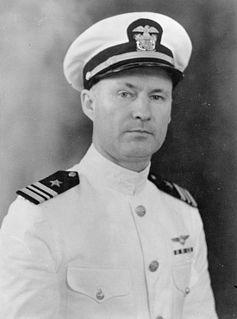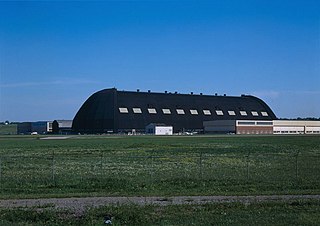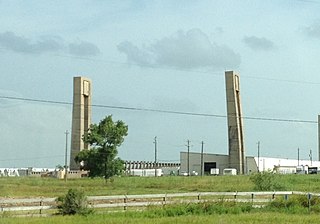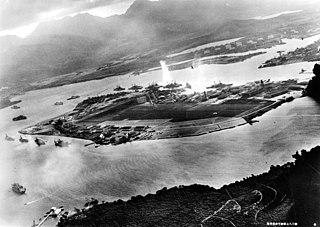
Moffett Federal Airfield, also known as Moffett Field, is a joint civil-military airport located in an unincorporated part of Santa Clara County between southern Mountain View and northern Sunnyvale, California. On November 10, 2014, NASA announced that it would be leasing 1000 acres of the airfield property to Google for 60 years.

A hangar is a closed building structure to hold aircraft, or spacecraft. Hangars are built of metal, wood and concrete. The word hangar comes from Middle French hanghart, of Germanic origin, from Frankish *haimgard, from *haim and gard ("yard").

Charles Emery Rosendahl was a highly decorated Vice Admiral in the United States Navy, and an advocate of lighter-than-air flight.

Lakehurst Maxfield Field, formerly known as Naval Air Engineering Station Lakehurst , is the naval component of Joint Base McGuire–Dix–Lakehurst, a United States Air Force–managed joint base headquartered approximately 25 miles (40 km) east-southeast of Trenton in Manchester Township and Jackson Township in Ocean County, New Jersey, United States. It is primarily the home to Naval Air Warfare Center Aircraft Division Lakehurst, although the airfield supports several other flying and non-flying units as well. Its name is an amalgamation of its location and the last name of Commander Louis H. Maxfield, who lost his life when the R-38/USN ZR-2 airship crashed during flight on 24 August 1921 near Hull, England.

The N-Class, or as popularly known, the "Nan ship", was a line of non-rigid airships built by the Goodyear Aircraft Company of Akron, Ohio for the US Navy. This line of airships was developed through many versions and assigned various designators as the airship designation system changed in the post World War II era. These versions included airships configured for both anti-submarine warfare and airborne early warning (AEW) missions.

The Goodyear Airdock is a construction and storage airship hangar in Akron, Ohio.

Naval Air Station Rockaway adjoined Fort Tilden on the western portion of the Rockaway Peninsula in the New York City borough of Queens. It was established on transferred municipal property in 1917 during American involvement in World War I, and was demolished in 1930 to make way for Jacob Riis Park. Operations were moved across the inlet to a hangar in the municipal Floyd Bennett Field, which itself was sold to the federal government in 1941 and made Naval Air Station New York. NAS New York was decommissioned in 1972 and is now a part of the Gateway National Recreation Area, as are Fort Tilden and Jacob Riis Park.

The American Blimp MZ-3A is a blimp owned by the United States Navy from 2006 to 2017. It is a modified American Blimp Corporation A-170 series commercial blimp and given the USN type/model/series (T/M/S) designation MZ-3A and Bureau Number (BuNo) 167811. After delivery to the Navy, the airship began operations as an advanced flying laboratory used to evaluate affordable sensor payloads, the development of new lighter-than-air (LTA) technologies and general flight support for other related research and development/science and technology (R&D/S&T) projects. It is currently the only airship operated by the U. S. military.

Hangar No. 1 is an airship hangar located at Naval Air Engineering Station Lakehurst in Manchester Township, in Ocean County, New Jersey, United States. It is best known as the intended destination of the rigid airship LZ 129 Hindenburg prior to the Hindenburg disaster on May 6, 1937, when it crashed and burned while landing.

Hangar One is one of the world's largest freestanding structures, covering 8 acres (3.2 ha) at the Moffett Field airship hangars site at Moffett Field, California, in Santa Clara County of the southern San Francisco Bay Area, California.
Airship hangars are specialized buildings that are used for sheltering airships during construction, maintenance and storage. Rigid airships always needed to be based in airship hangars because weathering was a serious risk.

Bartolomeu de Gusmão Airport was a Brazilian airport built to handle the operations with the rigid airships Graf Zeppelin and Hindenburg. The airport was named after Bartolomeu Lourenço de Gusmão (1685–1724), a Portuguese priest born in Brazil who did research about transportation with balloons.
The U.S. Naval Air Station, Sunnyvale Historic District, also known as Shenandoah Plaza is a historic district located on 62.48 acres (25.3 ha) at Moffett Field, California.
Weeksville in an unincorporated community in Pasquotank County, North Carolina, United States. It lies roughly midway on NC 344, at an elevation of 3 feet. The community is home to Weeksville Elementary School, a Methodist church, gas station, volunteer fire department, Lions Club chapter and county recycling center.
A hangar is a structure built to house aircraft. "Hangar" may also refer to:
In the nation's quest to provide security along its lengthy coastlines, air reconnaissance was put forth by the futuristic Rear Admiral William A. Moffett. Through his efforts, two Naval Air Stations were commissioned in the early 1930s to port the Naval Airships (dirigibles) which he believed capable of meeting this challenge.
The United States Navy proposed to the U.S. Congress the development of a lighter-than-air station program for anti-submarine patrolling of the coast and harbors. This program proposed, in addition to the expansion at NAS and Lakehurst, the construction of new stations. The original contract was for steel hangars, 960 ft (290 m) long, 328 ft (100 m) wide and 190 ft (58 m) high, helium storage and service, barracks for 228 men, a power plant, landing mat, and a mobile mooring mast.
There are three historic airship hangars at Moffett Field, in Mountain View in the southern San Francisco Bay Area, California. Hangar One is based on a structure of steel girders, while Hangars Two and Three are of wood. They are among the world's largest freestanding structures.




















